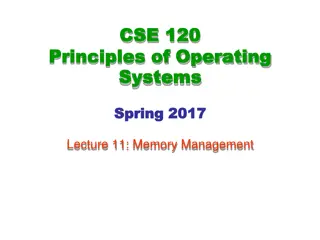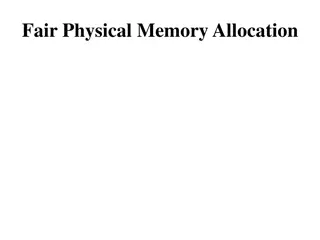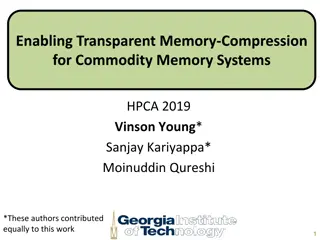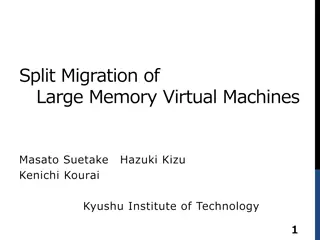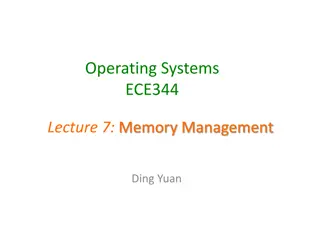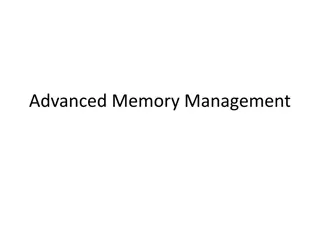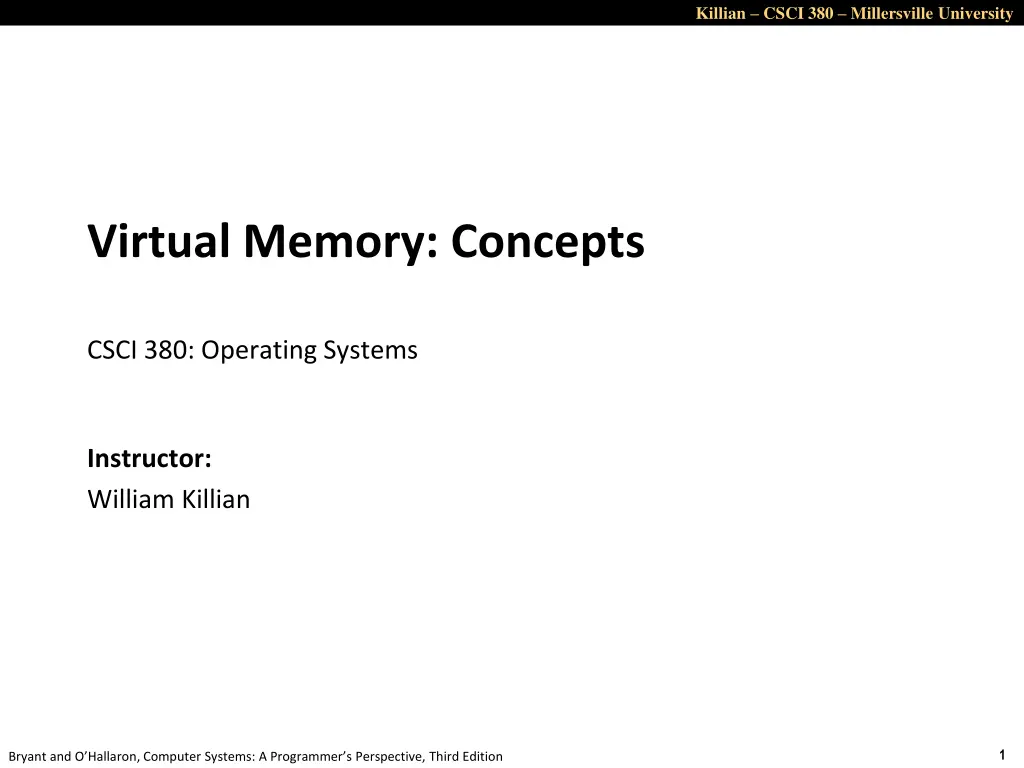
Understanding Virtual Memory and Shell Lab Concepts in CSCI 380 at Millersville University
Explore the concepts of virtual memory and shell lab in CSCI 380 at Millersville University through discussions on traces, sigsuspend usage, and critical code regions. Get insights into handling background jobs effectively and optimizing signal handling techniques.
Download Presentation

Please find below an Image/Link to download the presentation.
The content on the website is provided AS IS for your information and personal use only. It may not be sold, licensed, or shared on other websites without obtaining consent from the author. If you encounter any issues during the download, it is possible that the publisher has removed the file from their server.
You are allowed to download the files provided on this website for personal or commercial use, subject to the condition that they are used lawfully. All files are the property of their respective owners.
The content on the website is provided AS IS for your information and personal use only. It may not be sold, licensed, or shared on other websites without obtaining consent from the author.
E N D
Presentation Transcript
Killian CSCI 380 Millersville University Virtual Memory: Concepts CSCI 380: Operating Systems Instructor: William Killian 1 Bryant and O Hallaron, Computer Systems: A Programmer s Perspective, Third Edition
Killian CSCI 380 Millersville University Shell Lab FAQ The traces behave differently from command-line input! Some people are confused to find /bin/echo on their jobs list after running some trace files. Some traces (e.g. trace05) print what they re running before they run them. They do this by using /bin/echo. So if you see a mysterious /bin/echo show up on your jobs list, you shouldn t wonder why it got on your jobs list, you should wonder why it never got deleted. Moral of the story: open the trace file and see what it does! 2 Bryant and O Hallaron, Computer Systems: A Programmer s Perspective, Third Edition
Killian CSCI 380 Millersville University Shell Lab FAQ sigsuspend??? You can only use waitpid() once, but there are probably two places you probably need to reap children (one for foreground jobs, one for background jobs). Temptation: use waitpid() for background jobs; use sleep() or a tight loop (i.e., while(1) {}). This is okay for the assignment Correct solution: use sigsuspend to block your process until a signal arrives. int sigsuspend(const sigset_t *mask) Temporarily replaces the process s signal mask with mask, which should be the signals you don t want to be interrupted by. sigsuspend will return after an unblocked signal is received and its handler run. When it returns, it automatically reverts the process signal mask to its old value. 3 Bryant and O Hallaron, Computer Systems: A Programmer s Perspective, Third Edition
Killian CSCI 380 Millersville University Shell Lab FAQ: sigsuspend example int main() { sigset_t waitmask, newmask, oldmask; /* set waitmask with everything except SIGINT */ sigfillset(&waitmask); sigdelset(&waitmask, SIGINT); /* set newmask with only SIGINT */ sigemptyset(&newmask); sigaddset(&newmask, SIGINT); if (sigprocmask(SIG_BLOCK, &newmask, &oldmask) < 0) //oldmask now stores prev mask unix_error("SIG_BLOCK error"); /* CRITICAL REGION OF CODE (SIGINT blocked) */ /* pause, allowing ONLY SIGINT */ if (sigsuspend(&waitmask) != -1) unix_error("sigsuspend error"); /* RETURN FROM SIGSUSPEND (returns to signal state from before sigsuspend) */ /* Reset signal mask which unblocks SIGINT */ if (sigprocmask(SIG_SETMASK, &oldmask, NULL) < 0) unix_error("SIG_SETMASK error"); } 4 Bryant and O Hallaron, Computer Systems: A Programmer s Perspective, Third Edition
Killian CSCI 380 Millersville University Today Address spaces VM as a tool for caching VM as a tool for memory management VM as a tool for memory protection Address translation 5 Bryant and O Hallaron, Computer Systems: A Programmer s Perspective, Third Edition
Killian CSCI 380 Millersville University A System Using Physical Addressing Main memory 0: 1: 2: 3: 4: 5: 6: 7: 8: Physical address (PA) 4 CPU ... M-1: Data word Used in simple systems like embedded microcontrollers in devices like cars, elevators, and digital picture frames 6 Bryant and O Hallaron, Computer Systems: A Programmer s Perspective, Third Edition
Killian CSCI 380 Millersville University A System Using Virtual Addressing Main memory 0: 1: 2: 3: 4: 5: 6: 7: 8: CPU Chip Virtual address (VA) 4100 Physical address (PA) 4 MMU CPU ... M-1: Data word Used in all modern servers, laptops, and smart phones One of the great ideas in computer science 7 Bryant and O Hallaron, Computer Systems: A Programmer s Perspective, Third Edition
Killian CSCI 380 Millersville University Address Spaces Linear address space: Ordered set of contiguous non-negative integer addresses: {0, 1, 2, 3 } Virtual address space: Set of N = 2n virtual addresses {0, 1, 2, 3, , N-1} Physical address space: Set of M = 2m physical addresses {0, 1, 2, 3, , M-1} 8 Bryant and O Hallaron, Computer Systems: A Programmer s Perspective, Third Edition
Killian CSCI 380 Millersville University Why Virtual Memory (VM)? Uses main memory efficiently Use DRAM as a cache for parts of a virtual address space Simplifies memory management Each process gets the same uniform linear address space Isolates address spaces One process can t interfere with another s memory User program cannot access privileged kernel information and code 9 Bryant and O Hallaron, Computer Systems: A Programmer s Perspective, Third Edition
Killian CSCI 380 Millersville University Today Address spaces VM as a tool for caching VM as a tool for memory management VM as a tool for memory protection Address translation 10 Bryant and O Hallaron, Computer Systems: A Programmer s Perspective, Third Edition
Killian CSCI 380 Millersville University VM as a Tool for Caching Conceptually, virtual memory is an array of N contiguous bytes stored on disk. The contents of the array on disk are cached in physical memory (DRAM cache) These cache blocks are called pages (size is P = 2p bytes) Virtual memory Physical memory 0 VP 0 VP 1 Unallocated 0 Cached PP 0 PP 1 Empty Uncached Unallocated Cached Empty Uncached Cached Empty PP 2m-p-1 M-1 VP 2n-p-1 Uncached N-1 Virtual pages (VPs) stored on disk Physical pages (PPs) cached in DRAM 11 Bryant and O Hallaron, Computer Systems: A Programmer s Perspective, Third Edition
Killian CSCI 380 Millersville University DRAM Cache Organization DRAM cache organization driven by the enormous miss penalty DRAM is about 10x slower than SRAM Disk is about 10,000x slower than DRAM Consequences Large page (block) size: typically 4 KB, sometimes 4 MB Fully associative Any VP can be placed in any PP Requires a large mapping function different from cache memories Highly sophisticated, expensive replacement algorithms Too complicated and open-ended to be implemented in hardware Write-back rather than write-through 12 Bryant and O Hallaron, Computer Systems: A Programmer s Perspective, Third Edition
Killian CSCI 380 Millersville University Enabling Data Structure: Page Table A page table is an array of page table entries (PTEs) that maps virtual pages to physical pages. Per-process kernel data structure in DRAM Physical memory (DRAM) Physical page number or disk address VP 1 PP 0 Valid VP 2 PTE 0 null 0 1 1 VP 7 VP 4 PP 3 0 1 0 0 Virtual memory (disk) null PTE 7 1 VP 1 Memory resident page table (DRAM) VP 2 VP 3 VP 4 VP 6 VP 7 13 Bryant and O Hallaron, Computer Systems: A Programmer s Perspective, Third Edition
Killian CSCI 380 Millersville University Page Hit Page hit: reference to VM word that is in physical memory (DRAM cache hit) Physical memory (DRAM) Physical page number or disk address Virtual address VP 1 PP 0 Valid VP 2 PTE 0 null 0 1 1 VP 7 VP 4 PP 3 0 1 0 0 Virtual memory (disk) null PTE 7 1 VP 1 Memory resident page table (DRAM) VP 2 VP 3 VP 4 VP 6 VP 7 14 Bryant and O Hallaron, Computer Systems: A Programmer s Perspective, Third Edition
Killian CSCI 380 Millersville University Page Fault Page fault: reference to VM word that is not in physical memory (DRAM cache miss) Physical memory (DRAM) Physical page number or disk address Virtual address VP 1 PP 0 Valid VP 2 PTE 0 null 0 1 1 VP 7 VP 4 PP 3 0 1 0 0 Virtual memory (disk) null PTE 7 1 VP 1 Memory resident page table (DRAM) VP 2 VP 3 VP 4 VP 6 VP 7 15 Bryant and O Hallaron, Computer Systems: A Programmer s Perspective, Third Edition
Killian CSCI 380 Millersville University Handling Page Fault Page miss causes page fault (an exception) Physical memory (DRAM) Physical page number or disk address Virtual address VP 1 PP 0 Valid VP 2 PTE 0 null 0 1 1 VP 7 VP 4 PP 3 0 1 0 0 Virtual memory (disk) null PTE 7 1 VP 1 Memory resident page table (DRAM) VP 2 VP 3 VP 4 VP 6 VP 7 16 Bryant and O Hallaron, Computer Systems: A Programmer s Perspective, Third Edition
Killian CSCI 380 Millersville University Handling Page Fault Page miss causes page fault (an exception) Page fault handler selects a victim to be evicted (here VP 4) Physical memory (DRAM) Physical page number or disk address Virtual address VP 1 PP 0 Valid VP 2 PTE 0 null 0 1 1 VP 7 VP 4 PP 3 0 1 0 0 Virtual memory (disk) null PTE 7 1 VP 1 Memory resident page table (DRAM) VP 2 VP 3 VP 4 VP 6 VP 7 17 Bryant and O Hallaron, Computer Systems: A Programmer s Perspective, Third Edition
Killian CSCI 380 Millersville University Handling Page Fault Page miss causes page fault (an exception) Page fault handler selects a victim to be evicted (here VP 4) Physical memory (DRAM) Physical page number or disk address Virtual address VP 1 PP 0 Valid VP 2 PTE 0 null 0 1 1 VP 7 VP 3 PP 3 1 0 0 0 Virtual memory (disk) null PTE 7 1 VP 1 Memory resident page table (DRAM) VP 2 VP 3 VP 4 VP 6 VP 7 18 Bryant and O Hallaron, Computer Systems: A Programmer s Perspective, Third Edition
Killian CSCI 380 Millersville University Handling Page Fault Page miss causes page fault (an exception) Page fault handler selects a victim to be evicted (here VP 4) Offending instruction is restarted: page hit! Physical memory (DRAM) Physical page number or disk address Virtual address VP 1 PP 0 Valid VP 2 PTE 0 null 0 1 1 VP 7 VP 3 PP 3 1 0 0 0 Virtual memory (disk) null PTE 7 1 VP 1 Memory resident page table (DRAM) VP 2 VP 3 VP 4 Key point: Waiting until the miss to copy the page to DRAM is known as demand paging VP 6 VP 7 19 Bryant and O Hallaron, Computer Systems: A Programmer s Perspective, Third Edition
Killian CSCI 380 Millersville University Allocating Pages Allocating a new page (VP 5) of virtual memory. Physical memory (DRAM) Physical page number or disk address VP 1 PP 0 Valid VP 2 PTE 0 null 0 1 1 VP 7 VP 3 PP 3 1 0 0 0 Virtual memory (disk) PTE 7 1 VP 1 Memory resident page table (DRAM) VP 2 VP 3 VP 4 VP 5 VP 6 VP 7 20 Bryant and O Hallaron, Computer Systems: A Programmer s Perspective, Third Edition
Killian CSCI 380 Millersville University Locality to the Rescue Again! Virtual memory seems terribly inefficient, but it works because of locality. At any point in time, programs tend to access a set of active virtual pages called the working set Programs with better temporal locality will have smaller working sets If (working set size < main memory size) Good performance for one process after compulsory misses If ( SUM(working set sizes) > main memory size ) Thrashing: Performance meltdownwhere pages are swapped (copied) in and out continuously 21 Bryant and O Hallaron, Computer Systems: A Programmer s Perspective, Third Edition
Killian CSCI 380 Millersville University Today Address spaces VM as a tool for caching VM as a tool for memory management VM as a tool for memory protection Address translation 22 Bryant and O Hallaron, Computer Systems: A Programmer s Perspective, Third Edition
Killian CSCI 380 Millersville University VM as a Tool for Memory Management Key idea: each process has its own virtual address space It can view memory as a simple linear array Mapping function scatters addresses through physical memory Well-chosen mappings can improve locality Address translation 0 0 Physical Address Space (DRAM) Virtual Address Space for Process 1: VP 1 VP 2 ... PP 2 N-1 (e.g., read-only library code) PP 6 0 Virtual Address Space for Process 2: PP 8 VP 1 VP 2 ... ... M-1 N-1 23 Bryant and O Hallaron, Computer Systems: A Programmer s Perspective, Third Edition
Killian CSCI 380 Millersville University VM as a Tool for Memory Management Simplifying memory allocation Each virtual page can be mapped to any physical page A virtual page can be stored in different physical pages at different times Sharing code and data among processes Map virtual pages to the same physical page (here: PP 6) Address translation 0 0 Physical Address Space (DRAM) Virtual Address Space for Process 1: VP 1 VP 2 ... PP 2 N-1 (e.g., read-only library code) PP 6 0 Virtual Address Space for Process 2: PP 8 VP 1 VP 2 ... ... M-1 N-1 24 Bryant and O Hallaron, Computer Systems: A Programmer s Perspective, Third Edition
Killian CSCI 380 Millersville University Simplifying Linking and Loading Memory invisible to user code Kernel virtual memory Linking Each program has similar virtual address space Code, data, and heap always start at the same addresses. User stack (created at runtime) %rsp (stack pointer) Memory-mapped region for shared libraries Loading execve allocates virtual pages for .text and .data sections & creates PTEs marked as invalid The .text and .data sections are copied, page by page, on demand by the virtual memory system brk Run-time heap (created by malloc) Loaded from the executable file Read/write segment (.data, .bss) Read-only segment (.init, .text, .rodata) 0x400000 Unused 0 25 Bryant and O Hallaron, Computer Systems: A Programmer s Perspective, Third Edition
Killian CSCI 380 Millersville University Today Address spaces VM as a tool for caching VM as a tool for memory management VM as a tool for memory protection Address translation 26 Bryant and O Hallaron, Computer Systems: A Programmer s Perspective, Third Edition
Killian CSCI 380 Millersville University VM as a Tool for Memory Protection Extend PTEs with permission bits MMU checks these bits on each access Physical Address Space EXEC Process i: VP 0: SUP READ WRITE Address Yes No Yes No PP 6 VP 1: Yes No Yes Yes PP 4 PP 2 VP 2: Yes Yes Yes No PP 2 PP 4 PP 6 EXEC SUP READ WRITE Address Process j: PP 8 PP 9 VP 0: Yes No Yes No PP 9 VP 1: Yes Yes Yes Yes PP 6 PP 11 VP 2: Yes No Yes Yes PP 11 27 Bryant and O Hallaron, Computer Systems: A Programmer s Perspective, Third Edition
Killian CSCI 380 Millersville University Today Address spaces VM as a tool for caching VM as a tool for memory management VM as a tool for memory protection Address translation 28 Bryant and O Hallaron, Computer Systems: A Programmer s Perspective, Third Edition
Killian CSCI 380 Millersville University VM Address Translation Virtual Address Space V = {0, 1, , N 1} Physical Address Space P = {0, 1, , M 1} Address Translation MAP: V For virtual address a: P U { } MAP(a) = a if data at virtual address a is at physical address a in P MAP(a) = if data at virtual address a is not in physical memory Either invalid or stored on disk 29 Bryant and O Hallaron, Computer Systems: A Programmer s Perspective, Third Edition
Killian CSCI 380 Millersville University Summary of Address Translation Symbols Basic Parameters N = 2n : Number of addresses in virtual address space M = 2m : Number of addresses in physical address space P = 2p : Page size (bytes) Components of the virtual address (VA) TLBI: TLB index TLBT: TLB tag VPO: Virtual page offset VPN: Virtual page number Components of the physical address (PA) PPO: Physical page offset (same as VPO) PPN: Physical page number 30 Bryant and O Hallaron, Computer Systems: A Programmer s Perspective, Third Edition
Killian CSCI 380 Millersville University Address Translation With a Page Table Virtual address n-1 p p-1 0 Page table base register (PTBR) Virtual page number (VPN) Virtual page offset (VPO) Page table Valid Physical page number (PPN) Physical page table address for the current process Valid bit = 0: Page not in memory (page fault) Valid bit = 1 m-1 p p-1 0 Physical page number (PPN) Physical page offset (PPO) Physical address 31 Bryant and O Hallaron, Computer Systems: A Programmer s Perspective, Third Edition
Killian CSCI 380 Millersville University Address Translation: Page Hit 2 CPU Chip PTEA 1 PTE VA MMU CPU 3 Cache/ Memory PA 4 Data 5 1) Processor sends virtual address to MMU 2-3) MMU fetches PTE from page table in memory 4) MMU sends physical address to cache/memory 5) Cache/memory sends data word to processor 32 Bryant and O Hallaron, Computer Systems: A Programmer s Perspective, Third Edition
Killian CSCI 380 Millersville University Address Translation: Page Fault Exception Page fault handler 4 2 CPU Chip Victim page PTEA 1 5 VA PTE Cache/ Memory MMU CPU Disk 3 7 New page 6 1) Processor sends virtual address to MMU 2-3) MMU fetches PTE from page table in memory 4) Valid bit is zero, so MMU triggers page fault exception 5) Handler identifies victim (and, if dirty, pages it out to disk) 6) Handler pages in new page and updates PTE in memory Bryant and O Hallaron, Computer Systems: A Programmer s Perspective, Third Edition 7) Handler returns to original process, restarting faulting instruction 33
Killian CSCI 380 Millersville University Integrating VM and Cache PTE CPU Chip PTE PTEA hit PTEA PTEA PTEA miss CPU MMU Memory VA PA PA PA miss Data PA hit L1 Data cache VA: virtual address, PA: physical address, PTE: page table entry, PTEA = PTE address 34 Bryant and O Hallaron, Computer Systems: A Programmer s Perspective, Third Edition
Killian CSCI 380 Millersville University Speeding up Translation with a TLB Page table entries (PTEs) are cached in L1 like any other memory word PTEs may be evicted by other data references PTE hit still requires a small L1 delay Solution: Translation Lookaside Buffer (TLB) Small set-associative hardware cache in MMU Maps virtual page numbers to physical page numbers Contains complete page table entries for small number of pages 35 Bryant and O Hallaron, Computer Systems: A Programmer s Perspective, Third Edition
Killian CSCI 380 Millersville University Accessing the TLB MMU uses the VPN portion of the virtual address to access the TLB: T = 2t sets VPN TLBT matches tag of line within set n-1 p+t p+t-1 p p-1 0 TLB tag (TLBT) TLB index (TLBI) VPO Set 0 v tag v tag PTE PTE TLBI selects the set Set 1 v tag v tag PTE PTE Set T-1 v tag v tag PTE PTE 36 Bryant and O Hallaron, Computer Systems: A Programmer s Perspective, Third Edition
Killian CSCI 380 Millersville University TLB Hit CPU Chip TLB PTE 2 3 VPN 1 PA VA MMU CPU Cache/ Memory 4 Data 5 A TLB hit eliminates a memory access 37 Bryant and O Hallaron, Computer Systems: A Programmer s Perspective, Third Edition
Killian CSCI 380 Millersville University TLB Miss CPU Chip TLB 4 2 PTE VPN 1 3 VA PTEA MMU CPU Cache/ Memory PA 5 Data 6 A TLB miss incurs an additional memory access (the PTE) Fortunately, TLB misses are rare. Why? 38 Bryant and O Hallaron, Computer Systems: A Programmer s Perspective, Third Edition
Killian CSCI 380 Millersville University Multi-Level Page Tables Level 2 Tables Suppose: 4KB (212) page size, 48-bit address space, 8-byte PTE Problem: Would need a 512 GB page table! 248 * 2-12 * 23 = 239 bytes Level 1 Table ... Common solution: Multi-level page table ... Example: 2-level page table Level 1 table: each PTE points to a page table (always memory resident) Level 2 table: each PTE points to a page (paged in and out like any other data) 39 Bryant and O Hallaron, Computer Systems: A Programmer s Perspective, Third Edition
Killian CSCI 380 Millersville University A Two-Level Page Table Hierarchy Level 1 page table Virtual memory Level 2 page tables 0 VP 0 ... PTE 0 PTE 0 VP 1023 2K allocated VM pages for code and data ... PTE 1 VP 1024 PTE 1023 PTE 2 (null) ... PTE 3 (null) VP 2047 PTE 4 (null) PTE 0 PTE 5 (null) ... PTE 6 (null) PTE 1023 6K unallocated VM pages Gap PTE 7 (null) PTE 8 1023 null PTEs (1K - 9) null PTEs 1023 PTE 1023 1023 unallocated pages unallocated pages VP 9215 1 allocated VM page for the stack 32 bit addresses, 4KB pages, 4-byte PTEs ... 40 Bryant and O Hallaron, Computer Systems: A Programmer s Perspective, Third Edition
Killian CSCI 380 Millersville University Translating with a k-level Page Table Page table base register (PTBR) VIRTUAL ADDRESS n-1 p-1 0 VPN 1 VPN 2 ... VPN k VPO Level k page table Level 2 page table Level 1 page table ... ... PPN m-1 p-1 0 PPN PPO PHYSICAL ADDRESS 41 Bryant and O Hallaron, Computer Systems: A Programmer s Perspective, Third Edition
Killian CSCI 380 Millersville University Summary Programmer s view of virtual memory Each process has its own private linear address space Cannot be corrupted by other processes System view of virtual memory Uses memory efficiently by caching virtual memory pages Efficient only because of locality Simplifies memory management and programming Simplifies protection by providing a convenient interpositioning point to check permissions 42 Bryant and O Hallaron, Computer Systems: A Programmer s Perspective, Third Edition













